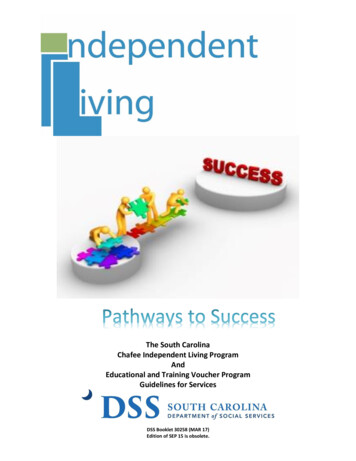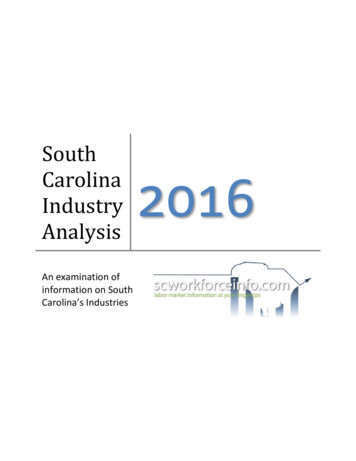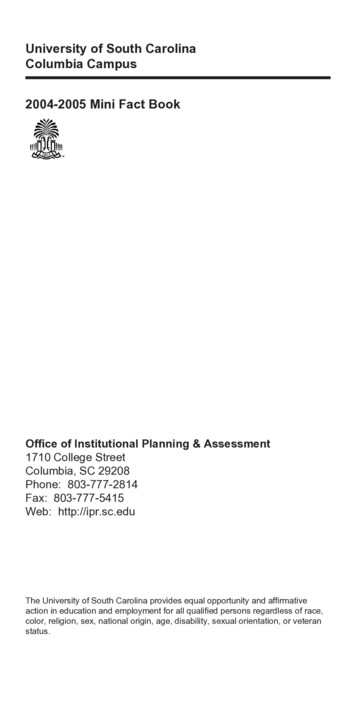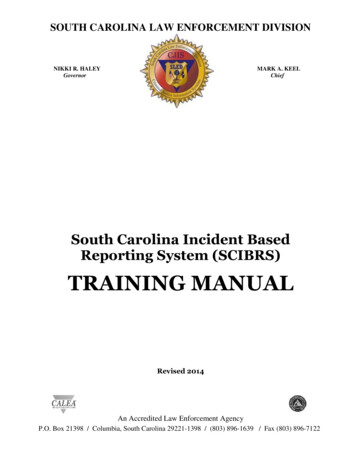
Transcription
The South CarolinaChafee Independent Living ProgramAndEducational and Training Voucher ProgramGuidelines for ServicesDSS Booklet 30258 (MAR 17)Edition of SEP 15 is obsolete.
TABLE OF CONTENTSIntroduction . . . . . . . 1Engaging Youth in Preparing For the Future . 3Who is Eligible for Chafee and ETV Funds? . 7How to Apply for Chafee Funding . 10Available Funded Services . . 12-19Services Not Included . 20Educational Opportunities .21Services Available Through ETV Funds . 23How to Apply for ETV Funding . 24Partnership Resources . . . . 25-27Additional Paperwork Needed to Apply. Appendix AGuidelines for Requesting Checks . . Appendix BFederal Guidelines: In and Out Residency Status . Appendix C
IntroductionPathways to SuccessSouth Carolina Chafee Independent Living ProgramThe journey to adulthood is a critical transition for youth in foster care. It is a timewhen young adults learn to take on the primary responsibility for their futures andthe accompanying concerns of employment, education, healthcare, housing andhome management, and maintaining significant relationships with those who willcontinue to support and encourage them beyond the transition to independence.The Chafee Foster Care Independence Program was established with the passageof the Foster Care Independence Act of 1999 (PL 106-169). Chafee funds areintended to provide youth with opportunities to learn needed independent livingskills and increase the likelihood of successful transition from foster care toindependence. The Educational and Training Voucher (ETV) Program wasestablished by the Promoting Safe and Stable Families Act of 2001 (PL 107-133). Thisprogram provides resources for youth who are transitioning from foster care tomeet their education and training needs.Youth can be best prepared by learning about both the challenges and theopportunities in the following areas: A supportive relationship with an adult and/or interpersonal connections tohelp them achieve their personal goals Education and training that enable youth to obtain and retain steadyemployment Gainful employment with future possibility for career growth Safe, stable, and affordable housing and access to transportation for work andschool Coverage within a managed care system for both physical and mental health1 Page
Purpose StatementThe South Carolina Department of Social Services and the Chafee IndependentLiving Program believes that youth should have the opportunities to reach andmaintain successful self-sufficiency. For this purpose, the Chafee IndependentLiving Program provides services and funding needed to enhance opportunities tolearn independent living skills necessary to become self-reliant.8 Purposes of Independent Living Program Help youth likely to remain in foster care until age 18 transition to selfsufficiency by providing services Help youth likely to remain in foster care until age 18 receive the education,training, and services necessary to obtain employment Help youth likely to remain in foster care until age 18 prepare for and enterpost-secondary training and educational institutions Provide personal and emotional support to youth aging out of foster carethrough mentors and the promotion of interactions with dedicated adults; Provide financial, housing, counseling, employment, education, and otherappropriate support and services to former foster care recipients between 18and 21 years of age to complement their own efforts to achieve self-sufficiencyand to assure that program participants recognize and accept their personalresponsibility for preparing for and then making the transition into adulthood; Make available vouchers for education and training, including postsecondaryeducation, to youth who have aged out of foster care; Provide services to youth who, after attaining 16 years of age, have left fostercare for kinship guardianship or adoption; and Ensure children who are likely to remain in foster care until 18 years of agehave regular, on-going opportunities to engage in age or developmentallyappropriate activities2 Page
Engaging Youth in preparing for The FutureEstablishing Youth-Centered Independent Living GoalsWhen a youth in foster care reaches the age of 13 or a youth enters care at age 13or older, the case manager will assist the youth in completing a Life SkillsAssessment. Sometimes, the case manager will work with the care provider to assistthe youth with this assessment.The Life Skills Assessment, such as Casey Life skills http://www.casey.org/casey-lifeskills-resources/, Washington Life Skills Inventory Assessment ds.org/, are used to identify a youth’s basic skills, emotionaland social capabilities, strengths, and needs. The information gathered with thistool is used to create an individualized case plan based on the specific needs of theyouth. Case planning should be a collaborative process involving the youth, the casemanager, the care provider, appropriate family members, and other adultsidentified as being significant to the youth and willing to support and encourage theyouth as he or she prepares to transition to independence.Case plans should contain specific goals to include employment, education, housing,life skills, physical and emotional health, and spiritual development. The plan shouldinclude steps that must be taken to achieve these goals. A Life Skills Assessment isre-administered on a yearly basis. Case plans should be revised as the youthdevelops and his or her needs change.3 Page
National Youth Transition Database NYTDThe National Youth in Transition Database (NYTD) project is a national researchstudy that tracks the independent living services and outcome measures of youthaging out of foster care in each state. The survey measures financial selfsufficiency, experience with homelessness, educational attainment, positiveconnections with adults, high-risk behavior, and access to health insurance.The National Youth in Transition Database is a national database that (1) surveysyouth about their thoughts and experiences of foster care services and (2) tracksthe independent living services that youth receive. The South Carolina Departmentof Social Services and The Center for Child and Family Studies at the University ofSouth Carolina are partners in this study, which is required by the US government.This database is used to document, track and evaluate services provided for youthin foster care. A NYTD service requires action from the provider or Case Manager specifically for preparing a youth for independence, education, housing, life skills,employment, etc. All Independent Living services funded by Chafee and ETV mustbe reported as NYTD services in the child welfare management and adultprotective services information system (CAPSS). It is a federal requirement torecord and update NYTD services in CAPSS under the “NYTD” tab (at leastmonthly).Case managers and care providers communicate at least once per month (UtilizeMonthly NYTD Tracking Form 30254 & keep copies in youth’s case file). Providethe care provider with access to the NYTD Services Booklet (Booklet 30255) tounderstand 14 NYTD categories. Missing or inaccurate information will result in aclassification of non-compliant when reporting information to the federalgovernment. Non-compliance could result in financial penalties placed on Chafeefunds.4 Page
Transition PlanningThe Fostering Connections and Increasing Adoptions Act of 2008 made it arequirement that, beginning at age 17, a youth in foster care must begin to developand implement a transition plan. The South Carolina Department of Social Servicesuses the Transition Plan Meeting form 30206 (formerly known as P.A.T.T.Y) for thispurpose. This plan must be formalized within the 90 days prior to the youth’s 17thbirthday. This form is used again at the formal transition planning meeting thatmust take place 90 days prior to a youth turning 18 and/or leaving care. TheTransition Plan Meeting form is used to identify areas in which services and skills areneeded in order to make a successful transition to independence. Assisting theyouth to identify and engage individuals in his or her support system is essential.Service providers, foster parents, family members, and any other individuals withwhom the youth has a positive connection should be invited to participate in thetransition planning meeting to develop the transition plan.Progress is evaluated monthly and the transition plan is updated as needed until theyouth leaves care and for a minimum of 6 months after the youth leaves care andcontinuing as long as the youth is receiving IL funding. Progress should bedocumented in after care line dictation.The Transition Plan Meeting form is also used when youth ages 18 – 21 who haveleft foster care request aftercare services.Why is the Transition Plan Important?It is important for youth to understand the process that needs to take place as theyprepare for adulthood. They should be encouraged to use their voices by activelyparticipating in the development of this plan. Youth should be assisted in identifyingtheir future goals and the steps necessary to achieve those goals. Youth in fostercare have the right to invite others to their transition planning meeting who aresignificant to them and will continue to support them as they prepare forindependence and beyond.5 Page
Youth must also assume their responsibility in making the transition successful. Thisrelies heavily on the youth’s ability to make appropriate decisions and followthrough on the objectives identified in the transition plan.Annual Credit Reporting for Case Managers and Youth In CareIn order to be and remain in compliance with Public Law 113-183, “child welfareagencies must ensure that youth in foster care receive a copy of any consumerreport, commonly called “credit report”, annually until discharged from care, andthat they be assisted in interpreting the credit report and resolving anyinaccuracies.” These reports will be obtained from three nationwide credit agencies(Transunion, Experian, and Equifax) each year the youth remain in foster care untilage 18, and if they remain in care beyond age 18.The Identity Theft Coordinator (ITC), a member of the Independent Living ProgramUnit, will submit a credit report history request for each youth age 14 and olderwho are in foster care annually and document the request for each youth’s creditreport history in CAPSS. If no credit report history is found, then youth and casemanager will receive notification but no report. The ITC will maintain updatedrecords concerning efforts taken to resolve any inaccuracies and will maintaincontact with youth and case managers throughout the process.6 Page
Who is Eligible for Chafee and ETV funds?Criteria for Chafee and ETV Recipients (5 categories) Youth in foster care (from age 13 until the 21st birthday) are eligible for all Chafeefunding and up to 5,000.00 in ETV funding for post-secondary schooling (college). Youth age 18 and older in a voluntary aftercare placement who have not yetreached age 21 are eligible for all Chafee funding and up to 5,000.00 in ETVfunding for post-secondary schooling (college). Youth who have left foster care or a voluntary aftercare placement after age 18,but have not yet reached their 21st birthday are eligible for all Chafee funding andup to 5,000.00 in ETV funding for post-secondary schooling (college). Anaftercare line must be opened and monthly contacts documented as long asaftercare youth are receiving funds. Youth who leave care to positive permanency (adoption/kinship/guardianship/reunification) at or after age 16 are eligible for ALL Chafee funding EXCEPT housingfunds. Youth who leave for positive permanency must have been in foster care fora minimum of 6 months. They are also eligible for up to 5,000.00 in ETV fundingfor post-secondary schooling (college). Youth who are in post-legal Adoption Preservation Placement (from age 13 untilthe 21st birthday) and are case managed by SCDSS are eligible for ALL Chafeefunding EXCEPT housing funds while they are in Adoption Preservation Placement.They are also eligible for up to 5,000.00 in ETV funding for post-secondaryschooling (college) while in placement.7 Page
Additional notes for Criteria of Chafee and ETV Recipients: Youth with special needs qualify for IL services that may not be listed in thisbooklet and are reviewed and approved on a case by case basis. Please submit ILFunding Requests (form 30198) for any needed services that will assist youth withspecial needs in gaining developmentally appropriate IL skills. Court Ordered Unlicensed Parent placement is not considered foster care anddisqualifies the youth from receiving IL services regardless even if there is an openfoster care line. Youth must have been in foster care placement (providerreceiving DSS board payment) for at least 6 months prior and be 16 or older to stillbe legible for services. Youth who are undocumented must have Green Card to qualify for IL services. Youth are eligible to receive ETV up to age 23 if the youth started receiving ETVprior to the 21st birthday. Youth who are incarcerated are not eligible for Chafee or ETV funding or eligible tosign the Aftercare Agreement for Voluntary Placement for Young Adults 18-21Years Old (DSS Form 30136) during the time they are incarcerated (includes DJJyouth behind the fence). Youth from South Carolina but currently residing in another state are eligible forservices. The new/receiving state may ask for a breakdown of all Chafee fundsapproved for the youth in order not to duplicate the same service in that state.Please see “Federal Guidelines: Resident Status and State Reasonability to PayChafee and ETV” in Appendix C. Youth who are ICPC (regardless of where they live, youth who are under the casemanagement responsibility of South Carolina) are under normal eligibility forChafee and ETV as a South Carolina resident. The new/receiving state may ask fora breakdown of all Chafee funds approved for the youth in order not to duplicatethe same service in that state. Please see “Federal Guidelines: Resident Status andState Reasonability to Pay Chafee and ETV” in Appendix C.8 Page
The link for IL contacts in all states GFunctionsaction rols:main.dspROL&rolType Custom&RS ID 145Youth ages 18 and older All youth 18 and older who are in care must have both foster care line andaftercare lines open to receive IL funding. Those who age out of care and are not in placement must have aftercarelines for a minimum of 6 months or as long as the youth is receiving ILservices. All youth 18 and older who are receiving IL services (including ETV andHousing Assistance) must have monthly documented contact with assignedcase manager. Youth who have been in foster care in the past should apply at the DSS officeof their county of residence for Aftercare placement. Youth are eligible ifthey are in school, working, or have a disabling condition. The county of theyouth’s current residence should contact the county in which the youth wasin foster care to verify the date the youth exited care and to gatherinformation about any connections the youth may have had with adults inthat county. The county of current residence should serve the youth in assisting withapplication for aftercare IL services as necessary.9 Page
How to Apply for Chafee FundingFunding requests for Chafee Independent Living Funds are submitted to theRegional Independent Living Advocate on DSS Form 30198. Please include therequired documentation for each item checked on page 2 of the form 30198 (seeappendix A). Applications are sent to the Regional Independent Living Advocatedesignated for the county or regional office assigned to the case.Applications will be reviewed as they are received on an ongoing basis. Casemanagers are contacted via email or telephone by the Regional Independent LivingAdvocates when more information is needed. Upon receipt of completed fundingrequest with all necessary documentation, a decision regarding approval will bemade and the county will be notified.Applications can be faxed, emailed, or mailed. All non-DSS requestors must mail orfax the request form in order to protect youth’s confidentiality; only DSS staff mayemail the 30198 form. If the application is faxed, it is not necessary to mail or emailthe request. Email requests to IndependentLiving@dss.sc.gov .Checklist for submitting IL services Completed IL request DSS form 30198Domain 8 of the child assessmentDictation for after care line youth (For youth age 18 and older)Education ScreenSupporting Documentation of each item requestedPlease ensure COMPLETE funding requests are submitted. Incomplete requestslacking documentation will not be processed. Please provide any missing items ina timely manner before 30 days of request to avoid denial.10 P a g e
I Have An Approval Letter- Now What? Case Manager should scan the approval email into CAPSS dictation andSchedule an MS Outlook Calendar reminder two weeks from approval emaildate to “submit a Check Voucher Request to Business Office”. Case Manager should submit a Check Voucher Request (See Appendix B) tothe county Business office and provide the Approval Letter, Justification andclear Supporting Documents (See Appendix A). Make sure to document dateof request in CAPSS dictation.11 P a g e
Available Funded ServicesCHAFEE ServicesDaily Living SkillsThis includes programs which promote independence by teaching social skills.Examples include, but are not limited to: Life skills classes (i.e. financial management, parenting, etc.) Mentoring Activity Services (Does not cover behavioral interventionists)- up to 50 per month for a maximum of 600 per year Esteem-building activities such as chorus, band, arts programs, cheerleading,or team sports. Non-school sponsored activities (such as karate classes) up to 6 months peryear Participation in activities such as ROTC, band, chorus, cheerleading, or teamsports or camps that are related to spiritual development. Camps that provide at least one of the NYTD categories up to 4 weeks. IL fundsdoes not apply to summer programs for daycare or recreation-only purposes. Other community leadership programs/camps that will provide youth withopportunities to develop work force training and life skills, or diversity andcultural sensitivity skills.12 P a g e
Adult EducationThis includes programs which help the youth to attain a high school degree or itsequivalent. Youth may also receive funding assistance to complete supplementalcoursework to achieve goals.Examples of Adult Education items include, but are not limited to: GED Program- cost and materials Tutoring for GED- up to 1000/year Study Skills training - 200 Alternative educational programs (i.e. Midlands Middle College) Non-ETV college coursework Non-ETV vocational courseworkEducation Support ServicesServices and supplies needed to meet a youth’s educational goals.Examples Include: Tutoring – up to 1000/year Summer School Books and supplies for specialized classes such as lab fees, special calculators,uniforms for classes such as cosmetology, nursing, etc. and insurance forschool-issued equipment Expenses for school sponsored educational field trips Birth certificate necessary for school13 P a g e
Senior Expenses: One (1) Senior prom ticket, Senior Prom Night Packageincludes (max 250) for financial assistance (must provide copies of paidreceipt) towards prom attire, personal care services (does not include productpurchase), and prom pictures; senior fees, graduation invitations (max 250),cap and gown (max 150), year book, diploma plaque, senior pictures (max 200), high school senior ring (max 300) (college rings have a maximum of 450 and can be paid with Chafee funds as long as the youth has not yetreached age 21). Personal Computer Bundle for all post-secondary students and for 11th and12th grade high school students if the school does not provide personalcomputers. IL funds are not approved to purchase iPads/tablets. Must providedocumentation from the school that personal computers are not provided andhaving access to a computer will benefit youth’s educational goals. ComputerRequest Form 30197 must be completed and attached to IL Request Form30198.Graduate Awards Recognition for high school graduates (whether by diploma, certificate or GED) 100 Vocation or Technical School graduates- 200 College graduates - 250A recognition ceremony is held annually for all graduates. It is necessary tocomplete the graduate Invoice (DSS Form 30237) and mail or fax it to theIndependent Living Advocate who serves your county or regional office.14 P a g e
Pre-College Expenses College applications (up to 150)SAT/ACT preparation classesCollege Goal Sunday transportation (www.che.sc.gov)SAT/ACT fees (up to 3 of each test)Note: These fees may be waived for foster youth by school counselorsSpecial RecognitionFunds for tuition, uniforms, or other items needed to recognize and developspecial achievements or talents of youth. Examples include, but are not limitedto: Scholars Programs when selected or referred by school Attendance at youth conferences Honor/award travel expenses for youth to travel when being honored orawarded Assistance with Governor’s School expenses up to 500 per school year Conference presentation Academic Incentive - post-secondary students with at least a 3.0 GPA takingsix or more credit hours are eligible for 100 per semester (Max 300/year)15 P a g e
TransportationTransportation assistance is for post-secondary, vocational, or adult education andemployment purposes only. Transportation to Adult Ed/GED - maximum of 50/week Transportation to adult education, college or vocational school - maximum of 50/week. Transportation to job skills training (does not include VocationalRehabilitation) - maximum of 50/week Transportation assistance for college students to visit home two times eachsemester to maintain connections - 75 per visit for a maximum of four visitsper year. Distance must be more than 50 miles one way. Transportation to work - 50/week for a maximum of 3 months up to 650per year. Therapeutic foster parents may or may not receive transportationreimbursement due to contract specifics.Transportation-related services are to assist youth in obtaining self-sufficiency.Examples include: Bicycles- for youth ages 13-15, up to 150 and 75 for a helmet and lock. Foryouth ages 16-21 up to 250 and 75 for a helmet and lock. Purchase ofhelmets is mandatory. Maximum of 2 bicycles per youth, mandatory 3 yearwait before obtaining second bicycle. Youth must have IL goals related totransportation, employment, healthy living or social development. Driver’s Educations Course (for youth age 16 and older) State IDs, knowledge test, driver’s manual, beginner’s permit and driver’slicense fees16 P a g e
Repair and/or maintenance to a vehicle (MOPED does not qualify as avehicle) which a youth owns and is needed for education and/oremployment 1,750/year (case worker must verify repairs). Title must be inyouth’s name. If youth is a co – signer then the title must read youth’s nameAND the other individual name. Insurance assistance when youth (ages 18 – 21) own the vehicle (MOPEDdoes not qualify as a vehicle) and need transportation to school or work 600/year. Renewal is based on a case by case basis. Insurance policy musthave youth’s name as insurer not as an additional driver. Please look formultiple quotes and make sure insurance rates are reasonable for youth tomaintain.Employment ServicesThis includes services needed to obtain or maintain employment.Examples include: Certification courses for trades such as electronics, plumbing, first aid, lifeguard, etc. Child care for one month – Maximum of 400, when the youth is notreceiving ABC vouchers Interview Clothing - 200 for ages 15-17, an additional 300 when youthreaches 18 until age 21 for a maximum of 500 Uniforms and footwear - 250 Job skill training classes that directly relate to the youth’s goals Vocational equipment Birth certificate necessary for employment (for youth ages 15 ) License/Certification fees Professional attire for work or school for youth age 18 until age 21 that donot have an open foster care line of services - 600/year17 P a g e
Housing and Transition ExpensesThese expenses are related to youth establishing their own independent residenceafter becoming age 18 or for post-secondary students in need of assistance withinterim housing. Youth who leave care to adoption, reunification, guardianship,kinship care and youth in post-legal adoption preservation placement are noteligible for housing and transition funds.To qualify for assistance, youth must be employed and earning sufficient incometo maintain the residence once Chafee housing assistance has ended.Note: SSI recipients must be the payee of their SSI benefit in order to receiveChafee housing and transition assistance.Note: Boarding arrangements for youth age 18 and 19 will not be approved foryouth who are eligible to remain in voluntary aftercare placement or eligible toreturn to voluntary aftercare placement.Housing/Transition expenses are discussed and planned at the youth’s transitionplanning meeting. When making Housing/Transition funding requests, it isnecessary to include a copy of the youth’s Budget Analysis (DSS Form 30238), theyouth’s Transition Plan Meeting Form 30206 (formerly known as P.A.T.T.Y.), proofof employment for two (2) months, and Financial Literacy/Management coursecertificate (Contact your Regional IL Advocate for resources). Youth should beaware that this is a one-time award and thoughtfully consider readiness to utilizethese funds. These funds are not intended for temporary residence or transitionalresidency.18 P a g e
Examples of Housing Assistance include the following: Phone deposit (Max 150) Electric, gas, or water deposit (maximum of 300) Furniture (Max 2,500). If the youth is pregnant or has a child 3,000 isavailable due to additional furniture needs. No rental/rent to own invoices. Rental Application fees (Max 300) Rental Deposit Rental assistance for up to 6 months, paid as 3 months full and 3 deescalating months. Youth who are in the last trimester of pregnancy mayreceive 6 full months and 3 de-escalating.Interim Housing for College StudentsSummer housing funds are available for youth who are no longer in foster care andin need of housing assistance for the summer. The South Carolina ChafeeIndependent Living program will pay 450/month for a maximum of 3 months forsummer housing for students. Housing assistance is also available based on boardrate for December-January holidays if dormitories are closed. Interim housingfunds could be applied to apartment style dormitory housing that remains openduring holiday breaks (up to 40/day) if the youth has no permanent connectionor needs to maintain employment while in school.Youth with DisabilitiesA setup fee of 400.00 or a household shower through the SC-FPA is available foryouth transitioning from foster care to housing with the Department of Disabilitiesand Special Needs or Department of Mental Health.Emergency AssistanceTime limited emergency assistance is available for youth who are homeless or atrisk of homelessness while locating more stable housing arrangements. Pleasecontact IndependentLiving@dss.sc.gov for available resources.19 P a g e
Services NOT Included:Personal hygiene productsPrivate mental health counselingBaby-sitting or most child care expensesNon-educational school-sponsored tripsVacation travelClothing for use other than as described in this guidelines publicationMedical needsTransportation for visitations other than as described herePurchase of a carFood other than as described hereEntertainment appliances/expensesServices that can be funded through alternative sources(i.e. school districts or placement agencies)Memberships for organizations and/or clubs(except high school academic honorary organizations)20 P a g e
Educational OpportunitiesETV ServicesEducational and Training Vouchers are grants, funded by the federal governmentand administered by the states, awarded for youth with foster care experiencepursuing a post-secondary education in an approved educational program.Who is Eligible? Youth in the custody of the Department of Social Services with independentliving as part of the case plan Youth who were in the custody of DSS at 18 years of age Youth who leave care to positive permanency (adoption/kinship/guardianship/ reunification) at or after age 16 are eligible for ALL Chafeefunding EXCEPT housing funds. Youth who leave for reunification must havebeen in foster care for a minimum of 6 months.Note: Youth are eligible for ETV funds as long as they are in college, makingsatisfactory progress, and have not reached the age of 21, even if they are not incare. Youth are eligible until age 23 if they are enrolled in post-secondaryeducation and began participating in the ETV program prior to turning 21.The
Living Program believes that youth should have the opportunities to reach and maintain successful self-sufficiency. For this purpose, the Chafee Independent Living Program provides services and funding needed to enhance opportunities to learn independent living skills necessary










